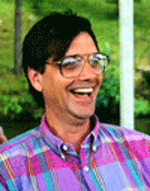
Contents:
New:
Margaret Chula: Poetry and Harmony in a Bowl of Tea
Mohammed Fakhruddin: Land and Sea...
Richard Powell: Still in the Stream
Bruce Ross: Sincerity and the Future of Haiku
Lee Gurga: Toward an Aestetic...
====
Aleksandar Ševo: Our Daily Haiku
Jim Kacian: Speech on Haiku in the Balkans
H. F. Noyes: Silence and Outreach in Haiku
H. F. Noyes: A Favourite Haiku
Susumu Takiguchi: Can the Spirit of Haiku be Translated?
Saša Važić: Roads and Side-Roads
Jim Kacian: What Do Editors Really Want?
Interview with Dimitar Anakiev


Lee Gurga, USA
The primary poetic technique of the haiku is the placing of two or three images side by side without interpretation. At least one of these images, or part of it, comes from the natural world. The second image relates to the first, sometimes closely, sometimes more ambiguously. This juxtaposition of images conveys a sense of significance to the reader by what has been called “internal comparison.” A space is created between the images in which the reader's emotions or understanding can lodge and grow. How these images relate to one another is a matter of some delicacy. The relationship cannot be too obvious or the poem will be trite, but if it is too distant, the association of images will appear forced or arbitrary. In the following haiku, by Pamela Miller Ness, the reader's eye will find two images —the obscured sun and the silence—and seek out the relationship between them:
sun blocked by clouds
mile after mile
in silence
Ness's images and their relationship are fairly straightforward and should not cause any problems of interpretation. This haiku, by Yu Chang, is a little more challenging:
starry night
biting into a melon
full of seeds
Even further apart are the images in Charles Trumbull's
the swell of her breast
against the watered silk—
summer moon
Each of these three haiku uses the internal comparison of two images to portray a scene that is much richer than the words (or images) alone would suggest.
Juxtaposed images can interact successfully in a number of ways. In more contemplative haiku the second image reinforces the first in mood or tone, producing a subdued poem, for example,
plum blossoms falling
the gardener softly singing
in my father's tongue
Sandra Fuhringer's haiku sets off a cascade of images and emotions, especially when one knows that in haiku plum blossoms signify very early spring.
If the second image interacts with the first in an unexpected way, the poem can carry us off onto a startling new trajectory. Sometimes what is unexpected is the associations of the images, as in this haiku by Robert Gilliland:
autumn wind—In addition to an unexpected aspect of the brown bag, the poet uses the common season word “autumn wind,” representing the beginning of the end of the annual cycle of nature, in an novel and chilling way.
Higginson has called this interaction between two images the “heart of haiku.” Others have likened the space between the images to the gap in a spark plug: if the space is too small, the charge leaks out. If it is too wide, there is no spark. When the gap is just right, the result can be electrifying. Here are two haiku, both on the subject of snow, that illustrate this point:
freshly fallen snow
opening a new package
of typing paper
mounted butterflies
snowflakes
through the window
In the first, by Nick Avis, the relationship between the new snow and a fresh packet of paper is clear, yet the association of the two images is itself fresh and suggestive. The second haiku, by Jerry Kilbride, draws a startling comparison between butterflies on display and snowflakes framed by the window. Traditional Japanese haiku aesthetics recognize several kinds of interactions between the images, including echo, contrast, and expansion. The poems by Avis and Kilbride are good examples of echo, where the second image reinforces the mood of the first. In a personal communication, poet Peggy Lyles writes of Kilbride's haiku:
We associate movement with both butterflies and snowflakes. The butterflies here are past that. The snowflakes move naturally but are not alive as the butterflies once were. Both are images of transience and the ephemeral. The butterflies are “preserved nature,” and thus transformed into art, as in Keats's “Grecian Urn.” Yet all the while we hold and re-experience the clear images of the moment and the poem.
A second image can be chosen for the contrast it provides, and the friction between the two can be the center of poetic interest, as in this haiku by Ruth Yarrow:
wild geese!Yarrow almost literally makes our head snap with her vigorous juxtaposition of images. Mark Brooks is doing something similar in this haiku, although his images have more space between them and require a greater involvement on the part of the reader.
spring rainThe feeling of expansion that we get when the second image is added to a haiku enlarges the first, often changing the focus from the specific to the universal or the local to the general and making the poem broaden in significance, as in this haiku by Robert Spiess
becoming dusk …Good haiku achieve what Spiess terms “the serene fusion of disparate elements.” A single image is like a lens—it helps us see details more clearly. Two images together are like a microscope or a telescope—they open up new worlds to us when we learn to use them skillfully.
From Haiku: A Poet's Guide by Lee Gurga, Modern Haiku Press, 2003.
See http://www.modernhaiku.org/mhbooks/gurgaHPG2003.html for more information.
Reprinted by permission of the author.